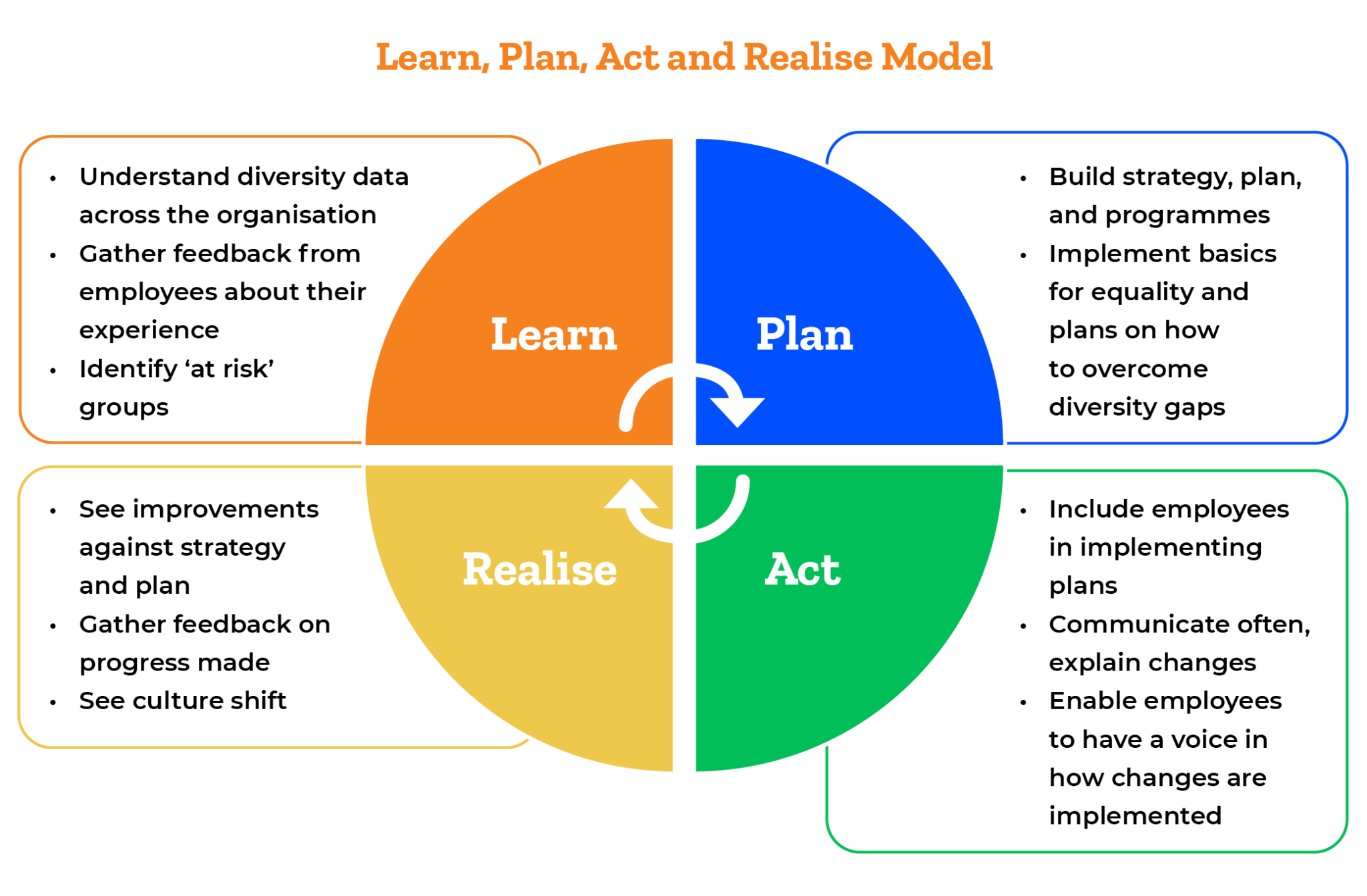Equality, Diversity, Inclusion and Belonging (EDIB) has never been more important, but the big question for many employers is ‘Where are you supposed to begin!?’ The Learn, Plan, Act and Realise Model allows you to review where you are on your EDIB journey and follow four simple steps to help you build a more inclusive culture, which starts with learning about the different perceptions of EDIB in your workplace.
The Learn, Plan, Act, Realise Model is all about giving you simple steps to follow that should be tailored and tempered to your situation. It works as a continuous improvement model that doesn’t prescribe instant, one-off fixes that may not be important to your people. Remember to focus your energy on the areas that will give you most return and help to further your journey in becoming more inclusive.

Every organisation is different and therefore there is no one-size-fits-all solution nor ‘final state’ to aim for when it comes to making your company successful in EDIB. What many employers fail to realise is that your EDIB journey should be continuous. After all, culture must be continuously developed. It is not a one-off exercise.
- Learn – gather data, listen to your people
- Plan – use that information to create the way your organisation will move forward
- Act – keep your promises and involve employees in taking action
- Realise – witness and celebrate the change you have made and gather feedback from employees to confirm your journey (and start it all over again)
Step one – Learn
In this blog, we will be taking you through stage one – the learning phase. Learning is about acknowledging and awareness. Acknowledging first that inequalities do exist in our societies, at work and at home, and seeing what we may not have seen before more clearly. It’s our job to ask what happened, why it happened, who benefitted, and how we got here.
To create a more inclusive culture, you must start by learning more about your organisation. You must understand your company’s diversity make-up and how well it represents the communities or customers you serve, as well as the geographical talent. Having diverse viewpoints at all levels of a business isn’t just a ‘feel-good’ initiative. It can improve financial results, organisational and team performance, innovation, and other areas of the business. Most importantly though, there’s nothing more important than ensuring your employees have a sense of belonging.
You can use data to understand if you have any gaps in representation that would benefit from being filled by office, team, and job role. If this data does not currently exist for your organisation, it is up to you to gather it, and explain to employees how the information will allow you to learn how you can become a more inclusive employer.
A diversity data capture can be viewed as a one-off event in an employee’s lifecycle. Where laws allow this and people are open to sharing, the best practice is to capture data when an employee joins a company. However, if your company isn’t set up to do this, you can ask for the information as part of a wider EDIB survey. You should explain to your people why their views matter and should be compared, depending on their diversity make up.
Data characteristics you can capture include age, gender or gender identity, sexuality, ethnicity and/or race, religion, disabilities, neurodiversity, caring responsibilities, socioeconomic background or social mobility and veteran status.
To understand employee perceptions on EDIB, what should you include in a survey?
It’s a good idea to have questions that measure if your employees believe your organisation is committed to EDIB. This means finding out their perceptions on how fair and equitably they think people are treated, how representative they think leadership is, how able they are to have a voice and feel heard and if they feel like they can be themselves. At WorkBuzz, we run employee engagement surveys for hundreds of organisations and this allows us to collect benchmark data for these three core questions.
By learning more about the diversity of your employees and getting their feedback, you’ll quickly be able to align these insights to business reporting tools and other data points within your organisation such as gender pay gap reporting, promotion, and performance review data.
It will also give you a sense about what’s going well and what you need to focus on to improve. By segmenting data by diversity demographics, you can quickly understand any turnover risks and focus on groups that have the lowest opinion on your EDIB efforts. By engaging employees, understanding their perceptions of EDIB in your workplace, and learning from them, you’re already on the pathway to becoming a more inclusive employer.
In our next blog, we will be discussing step 2 of the Model – Plan. But if you’d like a deep dive into how to progress your EDIB journey, download our latest eBook – Four steps to create a more inclusive culture.
